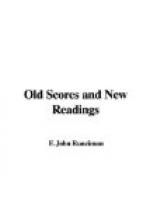The Requiem is a very different work. There is plenty of the gaiety and sunshine of life in “Don Giovanni.” The Requiem is steeped in sadness and gloom, with rare moments of fiery exaltation, or hysterical despair; at times beauty has been almost—almost, but never quite—driven from Mozart’s thought by the anguish that tormented him as he wrote. While speaking of Bach’s “Matthew” Passion, I have said it “was an appeal, of a force and poignancy paralleled only in the Ninth symphony, to the emotional side of man’s nature ... the aesthetic qualities are subordinated to the utterance of an overwhelming emotion.” Had I said “deliberately subordinated” I should have indicated the main difference as well as the main likeness between Bach’s masterwork and Mozart’s. The aesthetic qualities are subordinated to the expression of an overwhelming emotion in the Requiem, but not deliberately: unconsciously rather, perhaps even against Mozart’s will. Bach set out with the intention of using his art to communicate a certain feeling to his listeners; Mozart, when he accepted the order for a Requiem from that mysterious messenger clad in grey, thought only of creating a beautiful thing. But he had lately found, to his great sorrow, that his ways were not the world’s ways, and fraught with even graver consequences was the world’s discovery that its ways were not Mozart’s. Finding all attempts to turn him from his ways fruitless, the world fought him with contempt, ostracism, and starvation for weapons; and he lacked strength for the struggle. There had been a time when he could retire within himself and live in an ideal world of Don Giovannis and Figaros. But now body as well as spirit was over-wearied; spirit and body were not only tired but diseased; and when he commenced to work at the Requiem the time was past for making beautiful things, for his mind was preoccupied with death and the horror of death—the taste of death was already in his mouth. Had death come to him as to other men, he might have met it as other men do, heroically, or at least calmly, without loss of dignity. But it came to him coloured and made fearful by wild imaginings, and was less a thought than an unthinkable horror. He believed he had been poisoned, and Count Walsegg’s grey-clad messenger seemed a messenger sent from another world to warn him of the approaching finish. As he said, he wrote the Requiem for himself. In it we find none of the sunshine and laughter of “Don Giovanni,” but only a painfully pathetic record of Mozart’s misery, his despair, and his terror. It is indeed a stupendous piece of art, and much of it surpassingly beautiful; but the absorbing interest of it will always be that it is a “human document,” an autobiographical fragment, the most touching autobiography ever penned.




